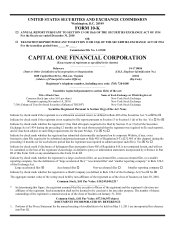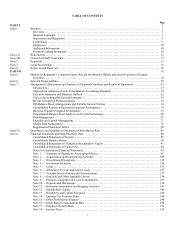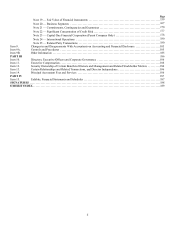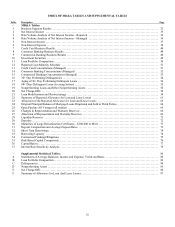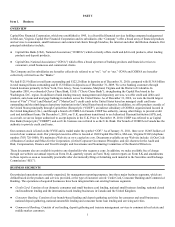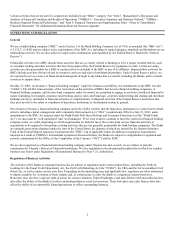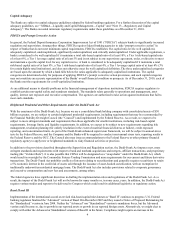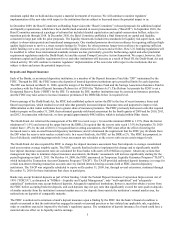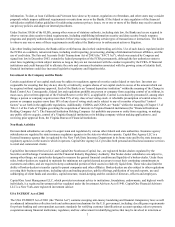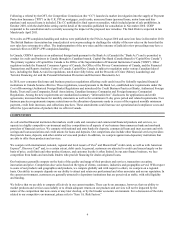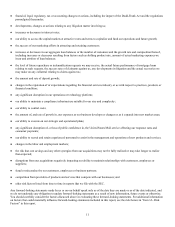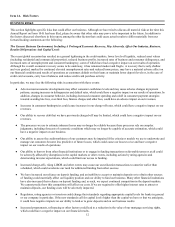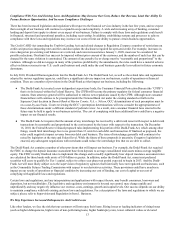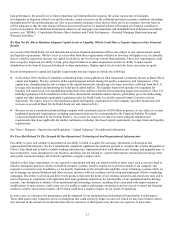Capital One 2010 Annual Report Download - page 25
Download and view the complete annual report
Please find page 25 of the 2010 Capital One annual report below. You can navigate through the pages in the report by either clicking on the pages listed below, or by using the keyword search tool below to find specific information within the annual report.5
minimum capital that we hold and also require a material investment of resources. We will continue to monitor regulators’
implementation of the new rules with respect to the institutions that are subject to them and assess the potential impact to us.
In December 2009, the Basel Committee on Banking Supervision (the “Basel Committee”) released proposals for additional capital
and liquidity requirements, which have been clarified and amended in recent pronouncements (“Basel III”). In September 2010, the
Basel Committee announced a package of reforms that included detailed capital ratios and capital conservation buffers, subject to
transition periods through 2018. In December 2010, the Basel Committee published a final framework on capital and liquidity,
consistent in large part with the prior proposals. The liquidity framework included two standards for liquidity risk supervision, each
subject to observation periods and transitional arrangements. One standard promotes short-term resilience by requiring sufficient high-
quality liquid assets to survive a stress scenario lasting for 30 days; the other promotes longer-term resilience by requiring sufficient
stable funding over a one-year period, based on the liquidity characteristics of assets and activities. How U.S. banking regulations will
be modified to reflect these international standards remains unclear, particularly given the forthcoming capital and other prudential
requirement regulations under the Dodd-Frank Act and the current Prompt Corrective Action framework. We expect, however, that
minimum capital and liquidity requirements for us and other institutions will increase as a result of Basel III, the Dodd-Frank Act and
related activity. We will continue to monitor regulators’ implementation of the new rules with respect to the institutions that are
subject to them and assess the potential impact to us.
Deposits and Deposit Insurance
Each of the Banks, as an insured depository institution, is a member of the Deposit Insurance Fund (the “DIF”) maintained by the
FDIC. Through the DIF, the FDIC insures the deposits of insured depository institutions up to prescribed limits for each depositor.
The DIF was formed on March 31, 2006, upon the merger of the Bank Insurance Fund and the Savings Association Insurance Fund in
accordance with the Federal Deposit Insurance Reform Act of 2005 (the “Reform Act”). The Reform Act permits the FDIC to set a
Designated Reserve Ratio (“DRR”) for the DIF. To maintain the DIF, member institutions may be assessed an insurance premium,
and the FDIC may take action to increase insurance premiums if the DRR falls below its required level.
Prior to passage of the Dodd-Frank Act, the FDIC had established a plan to restore the DIF in the face of recent insurance losses and
future loss projections, which resulted in several rules that generally increased deposit insurance rates and purported to improve risk
differentiation so that riskier institutions bear a greater share of insurance premiums. The FDIC previously had issued a rule that required
banks to prepay on December 31, 2009, their estimated quarterly risk-based assessment for the fourth quarter of 2009 and for 2010, 2011,
and 2012. In connection with that rule, we have prepaid approximately $462 million, which is included within Other Assets.
The Dodd-Frank Act reformed the management of the DIF in several ways: (1) raised the minimum DRR to 1.35% (from the former
minimum of 1.15%) and removed the upper limit on the DRR; (2) required that the reserve ratio reach 1.35% by September 30, 2020
(rather than 1.15% by the end of 2016); (3) required that in setting assessments, the FDIC must offset the effect of meeting the
increased reserve ratio on small insured depository institutions; and (4) eliminated the requirement that the FDIC pay dividends from
the DIF when the reserve ratio reaches certain levels. In a recent final rule, the FDIC set the DRR at 2%. The FDIC has proposed, in
lieu of dividends, establishing progressively lower assessment rate schedules as the reserve ratio meets certain trigger levels.
The Dodd-Frank Act also required the FDIC to change the deposit insurance assessment base from deposits to average consolidated
total assets minus average tangible equity. The FDIC recently finalized rules to implement this change and to significantly modify
how deposit insurance assessment rates are calculated for those banks with assets of $10 billion or greater. Absent any actions that
management may take to minimize deposit insurance assessments, the Banks’ assessments will increase significantly starting for the
period beginning on April 1, 2011. On October 14, 2008, the FDIC announced its Temporary Liquidity Guarantee Program (“TLGP”),
which included the Transaction Account Guarantee Program (“TAGP”). The TAGP provided unlimited deposit insurance coverage for
certain non-interest bearing transaction accounts and very limited interest-bearing accounts held at FDIC-insured depository
institutions. The TAGP was originally scheduled to expire on December 31, 2009, but, through several extensions, continued through
December 31, 2010 for those institutions that chose to participate.
Banks may accept brokered deposits as part of their funding. Under the Federal Deposit Insurance Corporation Improvement Act of
1991 (“FDICIA”), as discussed in “MD&A—Liquidity and Capital Management”, only “well-capitalized” and “adequately-
capitalized” institutions may accept brokered deposits. Adequately-capitalized institutions, however, must first obtain a waiver from
the FDIC before accepting brokered deposits, and such deposits may not pay rates that significantly exceed the rates paid on deposits
of similar maturity from the institution’s normal market area or, for deposits from outside the institution’s normal market area, the
national rate on deposits of comparable maturity.
The FDIC is authorized to terminate a bank’s deposit insurance upon a finding by the FDIC that the bank’s financial condition is
unsafe or unsound or that the institution has engaged in unsafe or unsound practices or has violated any applicable rule, regulation,
order or condition enacted or imposed by the bank’s regulatory agency. The termination of deposit insurance for a bank could have a
material adverse effect on its liquidity and its earnings.




